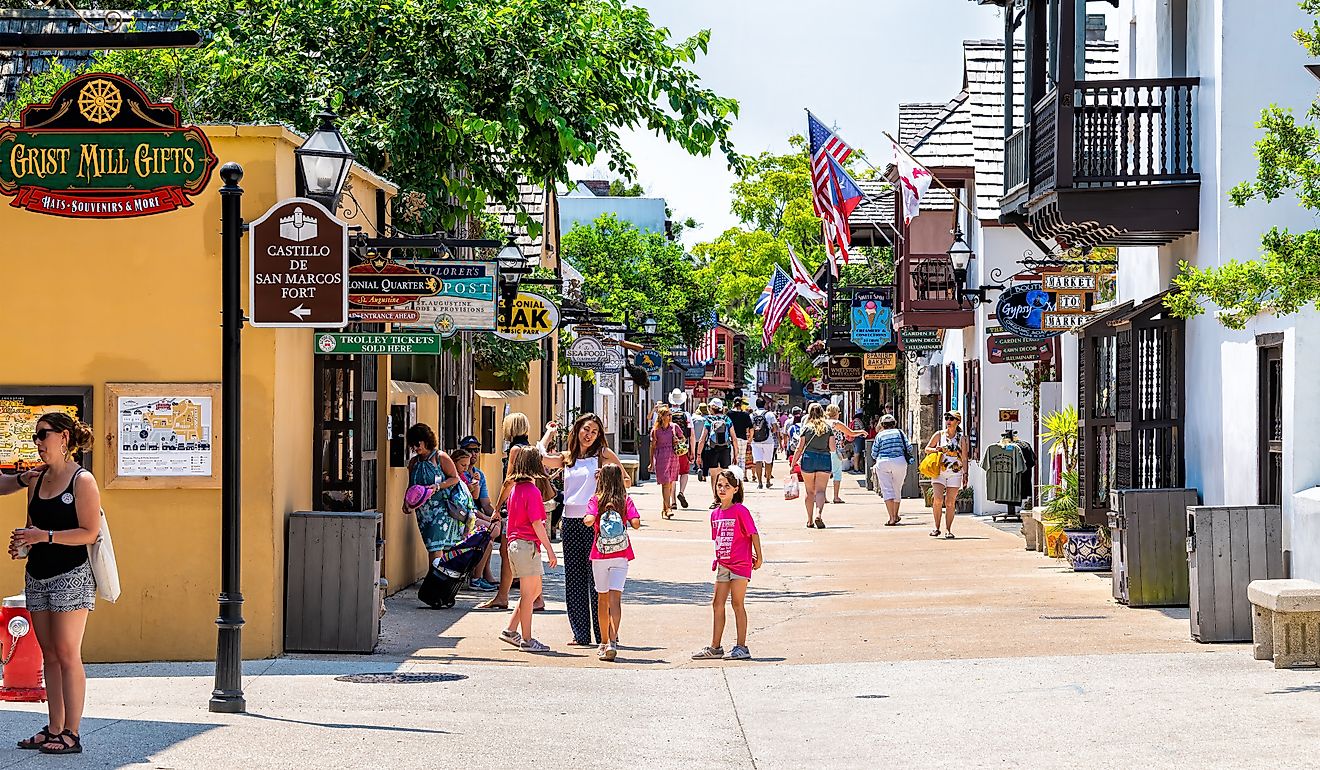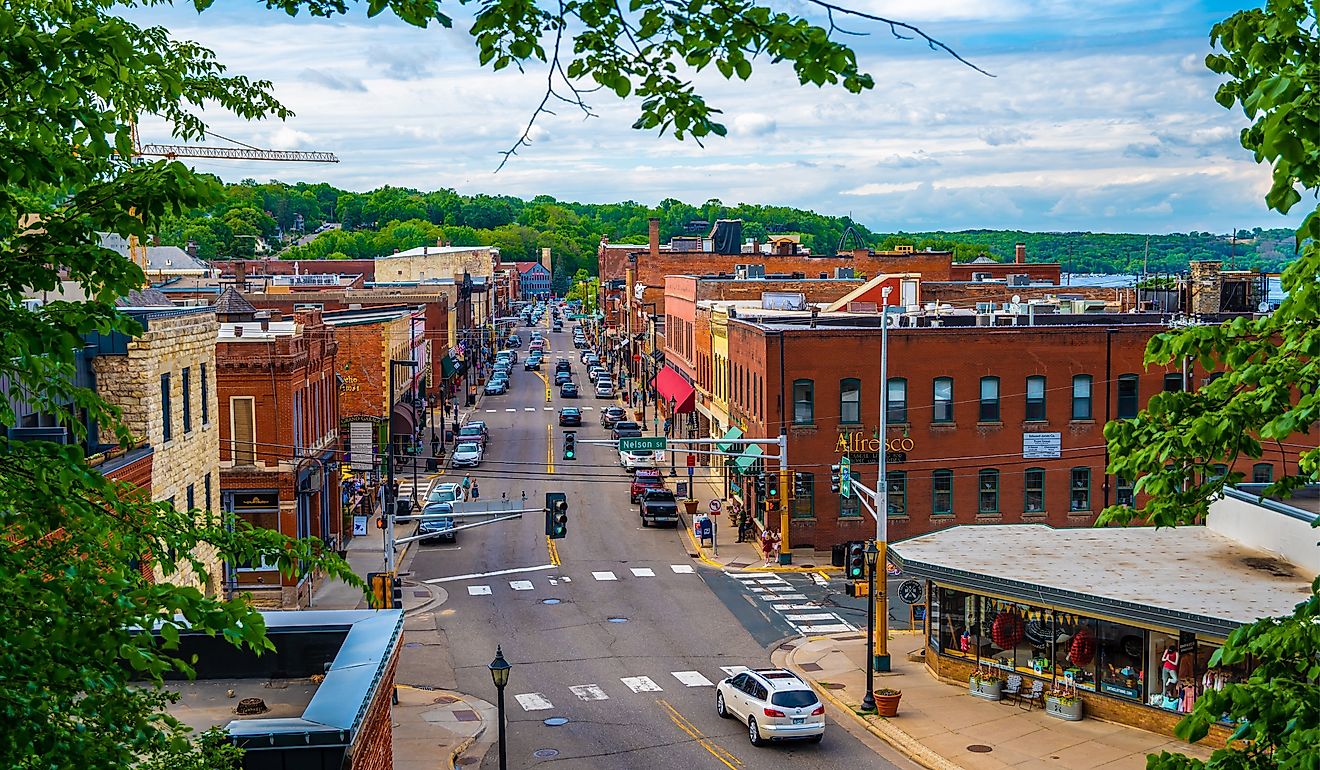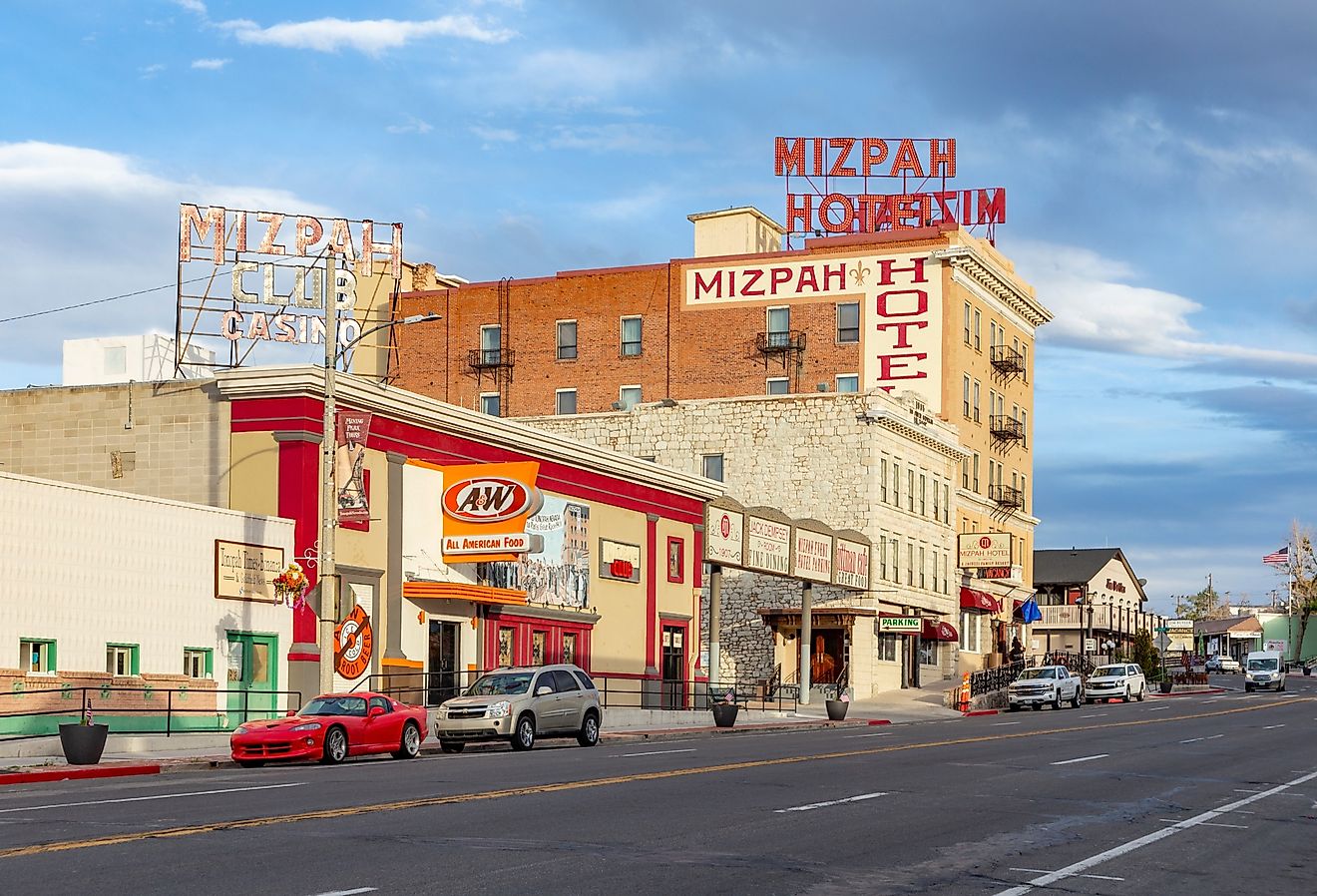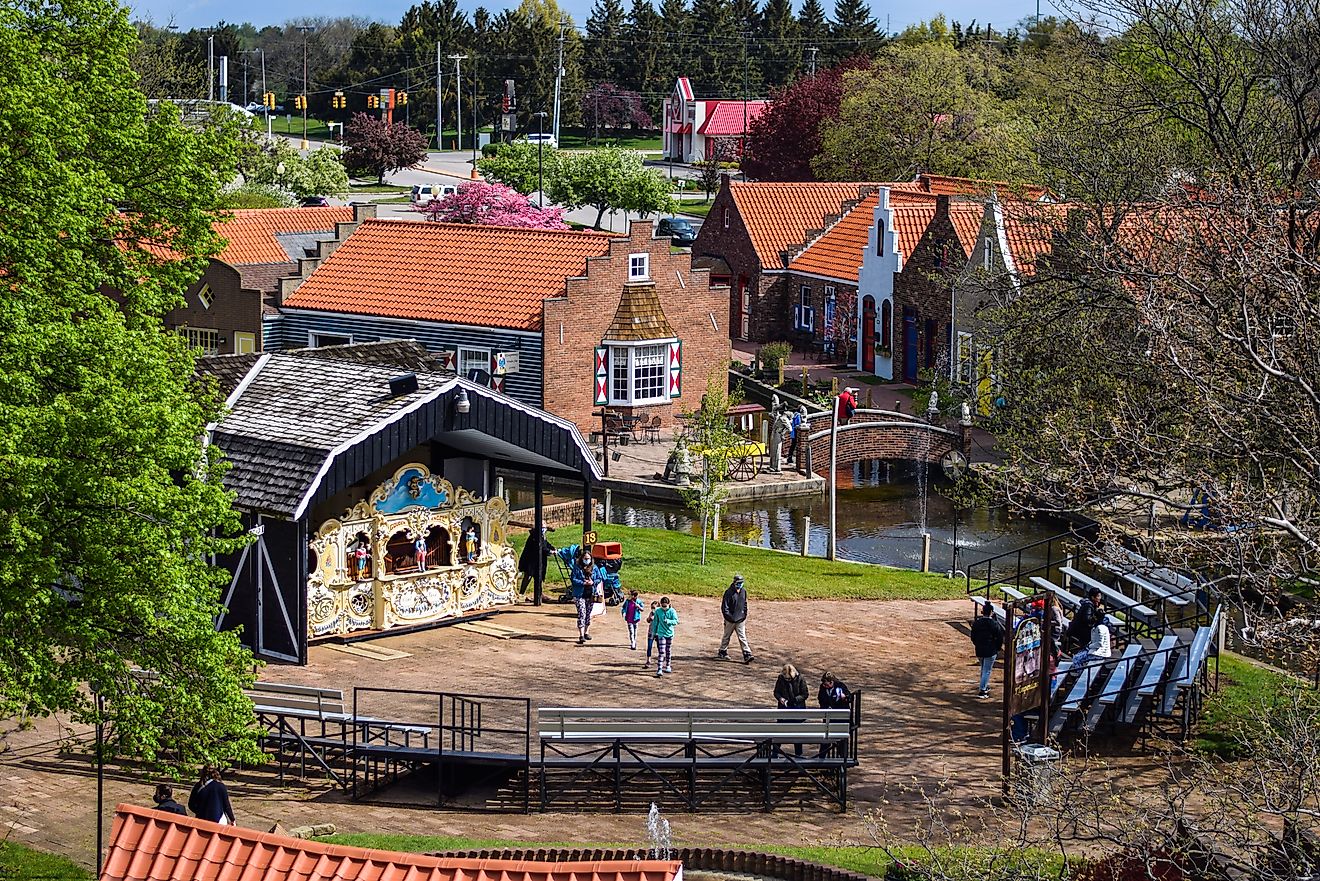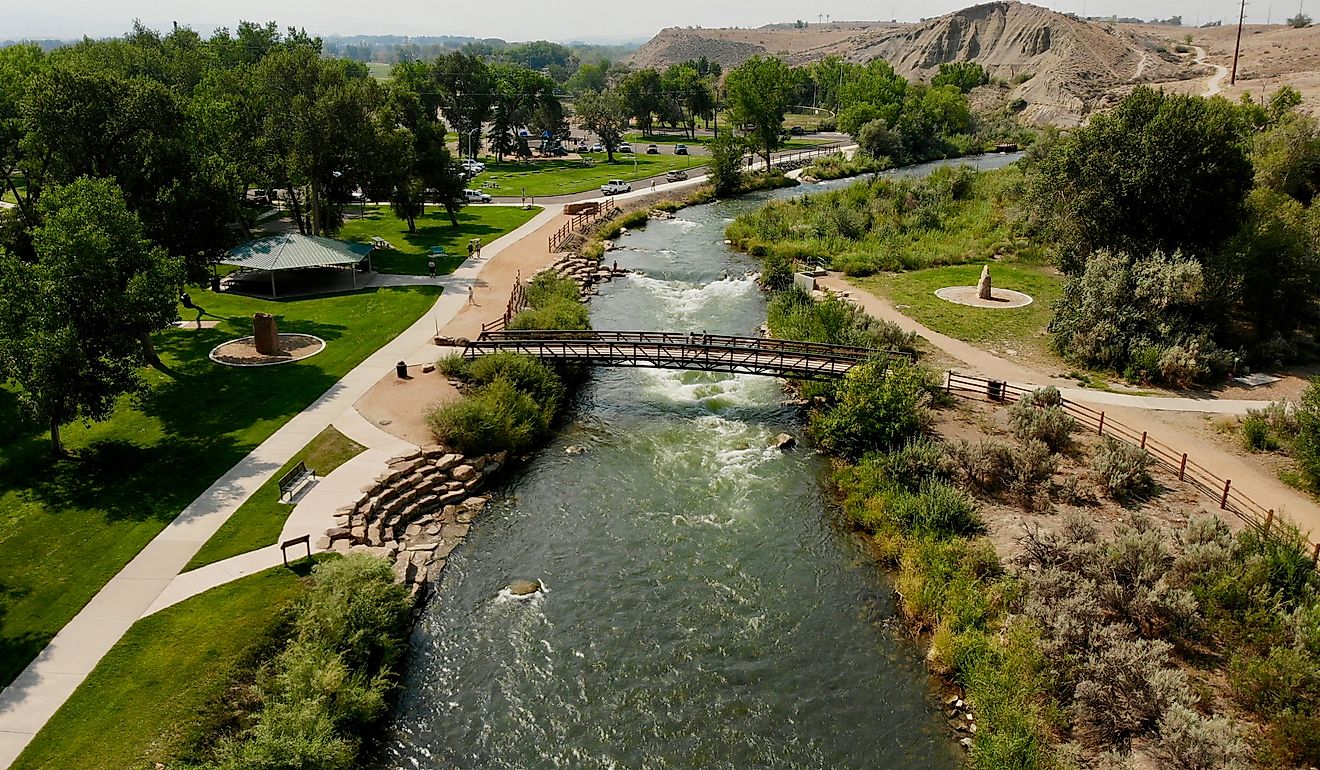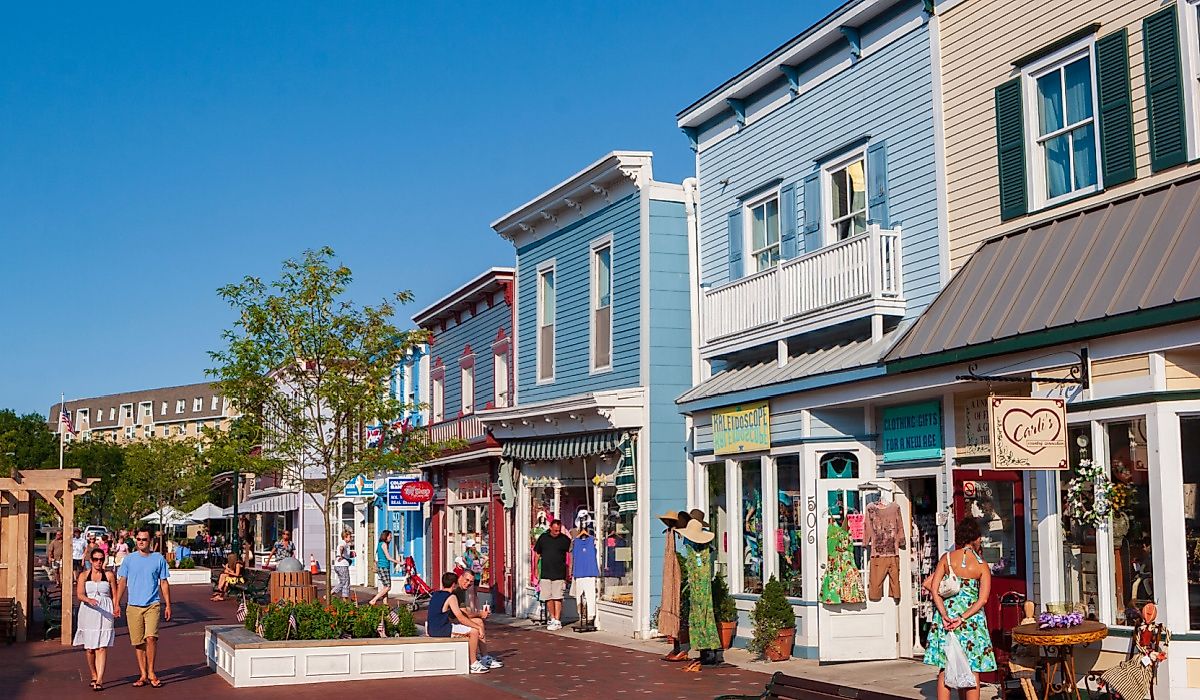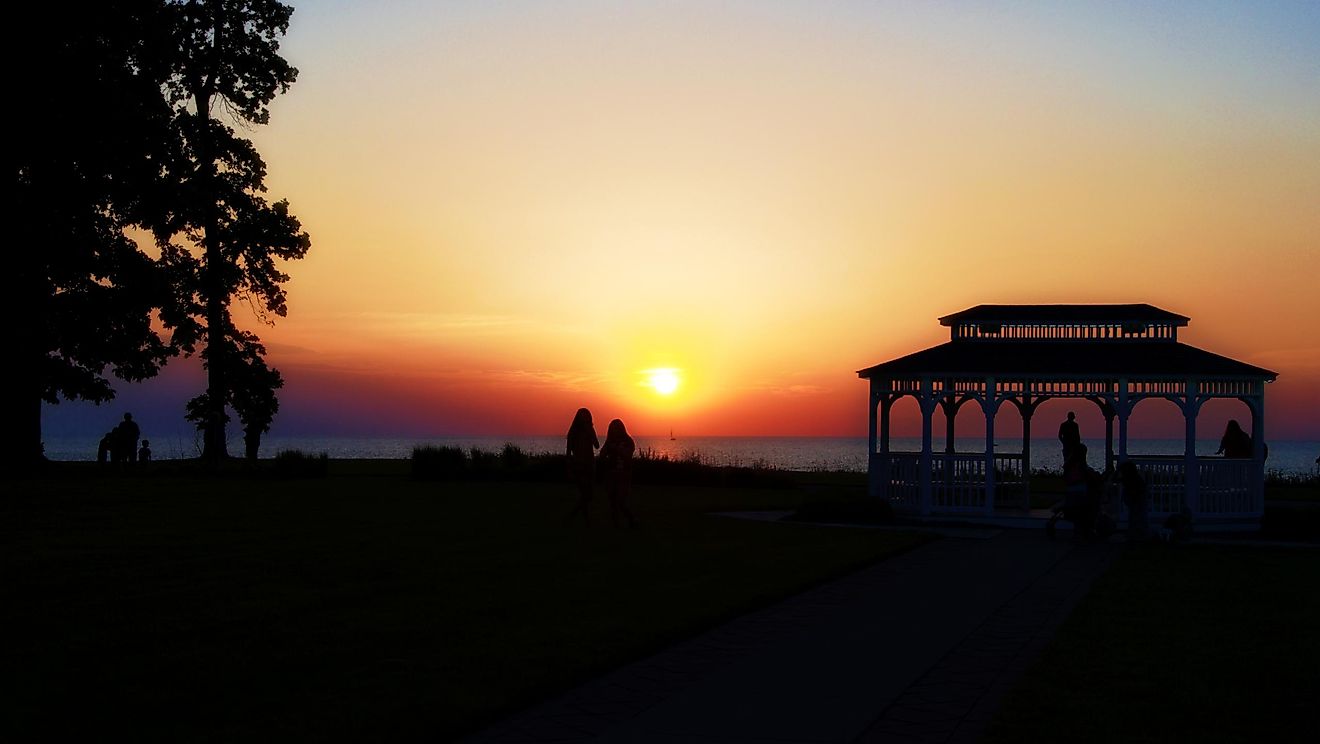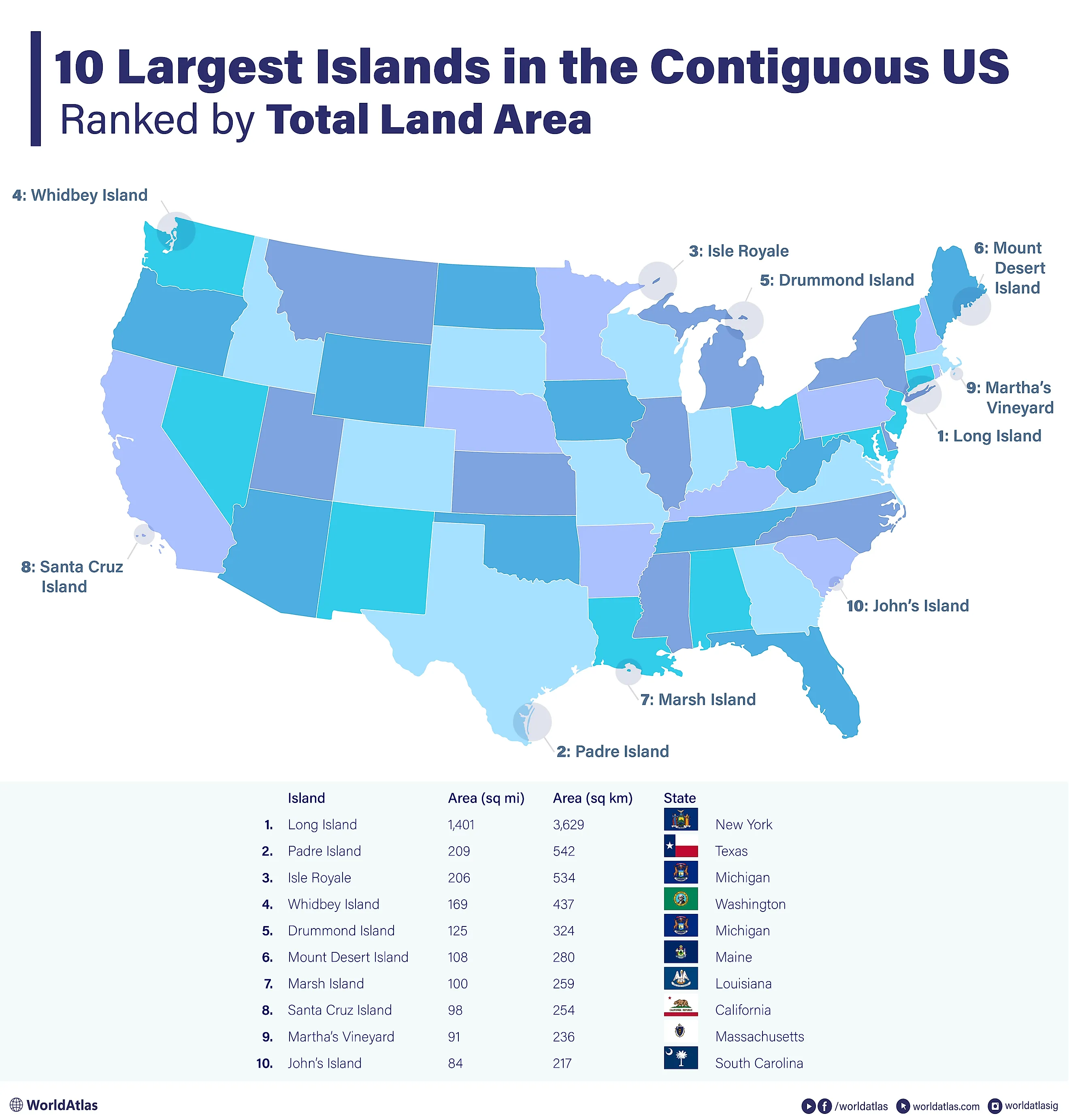
The Largest Islands In The Contiguous United States
While islands often bring to mind tropical getaways or remote escapes, the contiguous United States is home to some massive islands found not only along the Pacific and Atlantic coasts but also within the Great Lakes. Home to metropolises, isolated villages, and national parks, here are the ten largest islands spread throughout the contiguous US.
10 Largest Islands In The Contiguous US By Land Area
| Rank | Name of Island | Area (sq mi) | Area (sq km) | Location |
|---|---|---|---|---|
| 1 | Long Island | 1,401 | 3,629 | New York |
| 2 | Padre Island | 209 | 542 | Texas |
| 3 | Isle Royale | 206 | 534 | Michigan |
| 4 | Whidbey Island | 169 | 437 | Washington |
| 5 | Drummond Island | 125 | 324 | Michigan |
| 6 | Mount Desert Island | 108 | 280 | Maine |
| 7 | Marsh Island | 100 | 259 | Louisiana |
| 8 | Santa Cruz Island | 98 | 254 | California |
| 9 | Martha's Vineyard | 91 | 236 | Massachusetts |
| 10 | Johns Island | 84 | 217 | South Carolina |
Long Island, New York
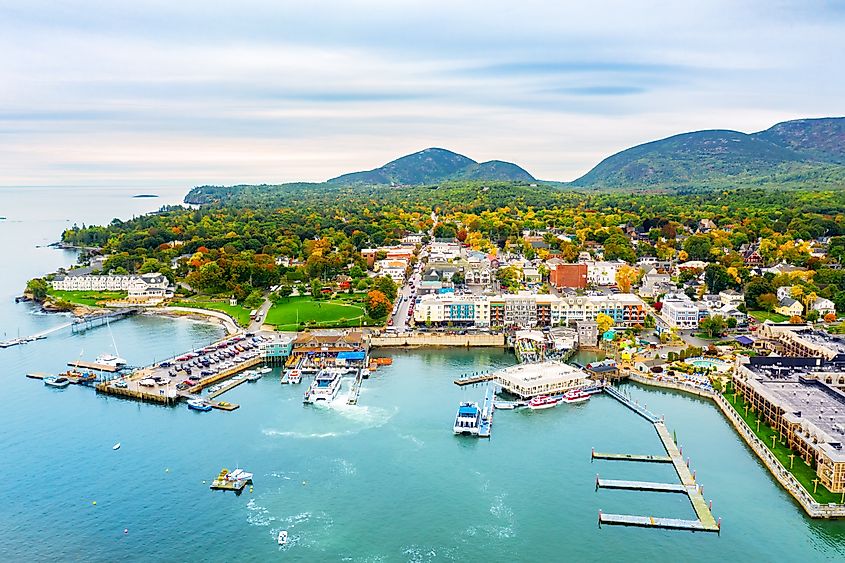
Aerial view of the Long Island coast on a sunny day.
Spanning 1,401 square miles, Long Island is by far the largest island in the contiguous United States. It is also the most populous, home to 8,063,232 residents per the 2020 census, which equates to 40% of the state’s total population. If Long Island were a US state, it would be the 13th most populous.
Situated in southeastern New York, the East River separates Long Island from the rest of the state, while Long Island Sound divides it from Connecticut. The island is made up of four counties—Kings (Brooklyn), Queens, Nassau, and Suffolk—while Manhattan and the Bronx lie across the East River to the west. Long Island is also home to two of the nation’s busiest airports, JFK International and LaGuardia.
Padre Island
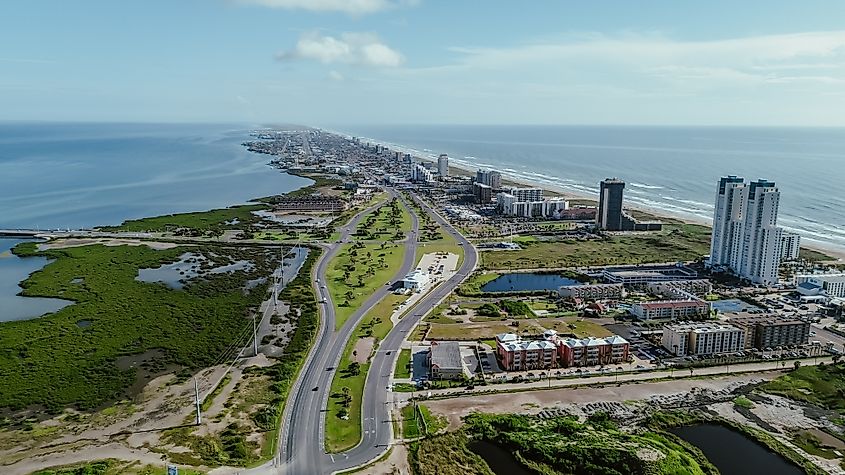
Lying along the Texas southeastern coast, Padre Island, covering 209 square miles, is the second largest island within the contiguous United States. A barrier island, it spans 113 miles southward from Corpus Christi to Port Isabel, stopping just short of the Mexican border. A little over 2,800 people reside on the island, the majority living in the north.
Laguna Madre, a shallow lagoon, separates Padre Island from mainland Texas, while the Port Mansfield Channel divides its southern end from neighboring South Padre Island. A large portion of the island was designated as a national seashore in 1962, and it now boasts the longest stretch of undeveloped barrier island in the country. The national seashore section of the island has an active program dedicated to turtle nesting, egg incubation, and the release of baby turtles.
Isle Royale, Michigan
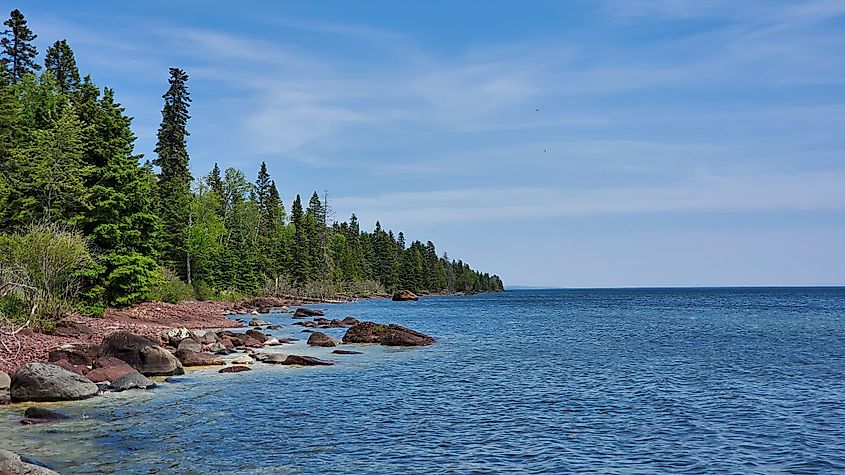
Isle Royale National Park on Lake Superior in Michigan.
Isle Royale, located in Lake Superior in northwest Michigan, is the third largest island in the contiguous United States with a surface of 206 square miles. It is closer to the Canadian province of Ontario, just 15 miles away, and 56 miles from the Michigan coast. Mount Desor, at 1,394 feet tall, is the island’s highest point.
Part of Isle Royale National Park, the island does not have any residents. However, the park received 28,965 visitors in 2023. Designated as a wilderness area in 1976, there are no roads on Isle Royal.
Whidbey Island, Washington
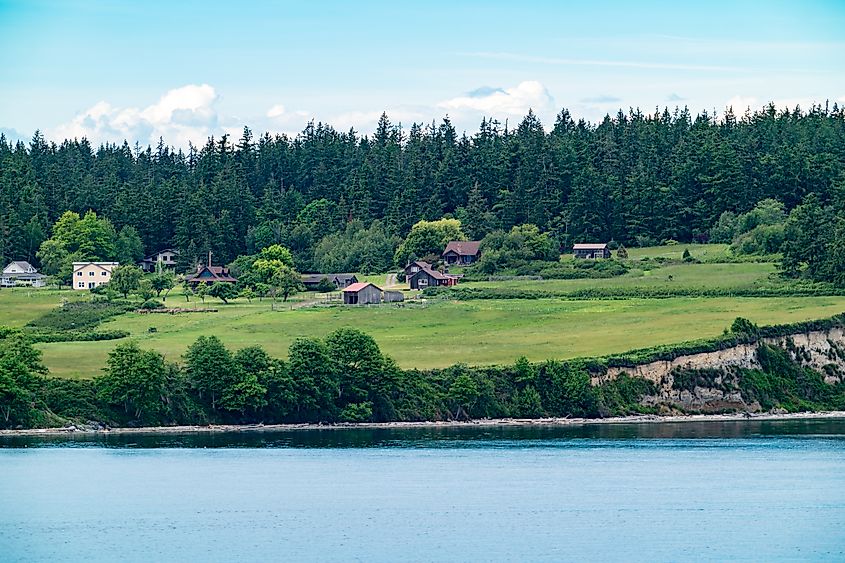
Double Bluff Beach on Whidbey Island in Freeland, Washington.
Situated in northwest Washington in Puget Sound, Whidbey Island covers 169 square miles, making it the fourth largest island within the contiguous US. An estimated 60,000 to 70,000 residents live on the island, including around 29,000 in rural areas in the southern part of the island. Its main towns include Oak Harbor, Coupeville, and Langley.
Built in 1935, the Deception Pass Bridge connects Whidbey Island to neighboring Fidalgo Island, with ferries also providing transportation access. The National Park Service designated a portion of the island as Ebey's Landing National Historical Reserve, the first national historic reserve, to preserve rural culture and rare native plants. Additionally, the island is home to six state parks.
Drummond Island, Michigan
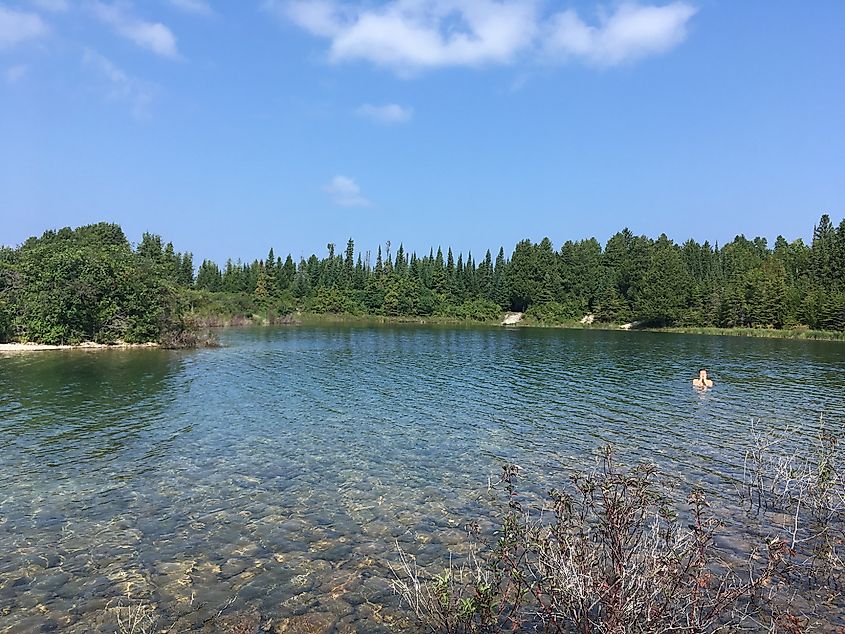
Drummond Island, located in northern Michigan in Lake Huron, is the fifth largest island in the contiguous United States, spanning 125 square miles. It is also the country’s second-largest freshwater island, after Isle Royal. Approximately 1,000 residents live on Drummond Island, which is connected to the mainland by the Drummond Island Ferry, running 365 days a year.
The island is home to 13 ecosystems, including six types of forests, five types of swamp marshes, cobble beaches, and inland lakes and rivers. There are also some cliffs to the east, part of the Niagra Escarpment. The only highway on Drummond Island is M-134.
Mount Desert Island, Maine
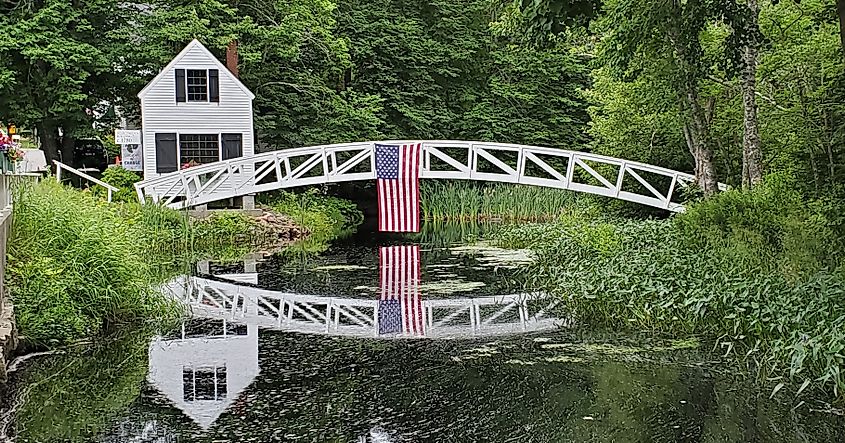
Mount Desert Island in Maine.
Located along Maine’s Atlantic coast, Mount Desert Island spans 108 square miles, making it the sixth largest island in the contiguous US. It lies within Frenchman Bay, while Somes Sound, a 6-mile-long fjord, nearly divides the island in half. In 1919, Acadia National Park, the first national park in the eastern United States, was established on the island.
Mount Desert Island has a local population of about 10,000 residents. However, this number increases drastically in the summer as visitors flock to Acadia National Park, which receives over 4 million visits annually. The 18 summits on the island are the Atlantic coast’s highest, north of Rio de Janeiro, with Cadillac Mountain the tallest at 1,530 feet.
Marsh Island, Louisiana
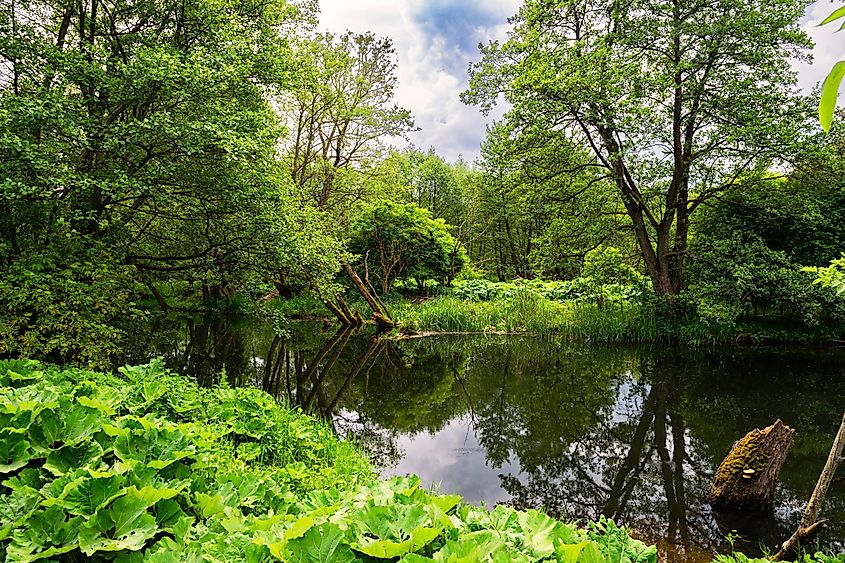
Marshland in a US natural park in Louisiana.
Marsh Island lies off of the coast of southern Louisiana and is the seventh largest island within the contiguous US at 100 square miles. It sits between the Gulf of Mexico and Vermillion Bay, with the majority of the land marshy and flat. No humans reside on the island.
Due to storm damage and erosion, Marsh Island has decreased nearly 9 square miles in size since 1920. The island is home to an important wildlife refuge, protecting numerous waterfowl species, shorebirds, birds of prey, fish species, furbearers, and alligators. Many people visit the island for shrimping, fishing, and crabbing as well.
Santa Cruz Island
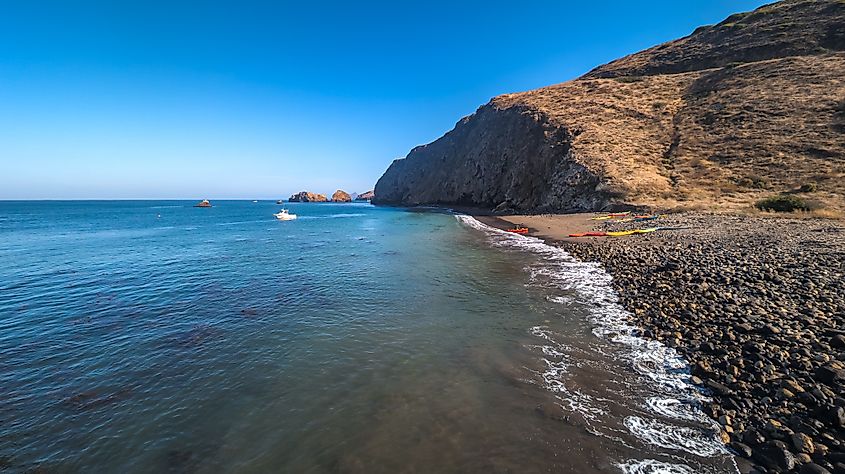
Channel Islands National Park in California.
Santa Cruz Island lies off of the southern coast of California, near the town of Ventura, California, and spans 98 square miles. It is considered part of Santa Barbara County, with the census from 2000 showing there to be a population of 2 people on the island. The National Park Service owns 24% of the island, while the Nature Conservancy owns the other 76%.
The island has a varied geography, including two mountain ranges, a central valley, 77 miles of coastline cliffs, canyons with springs and streams, beaches, sea caves, and tidepools. Over 150 species of animals can be found on the island as well. The island scrub-jay and eight species of plants exist only on Santa Cruz, having evolved in isolation over millions of years.
Martha’s Vineyard
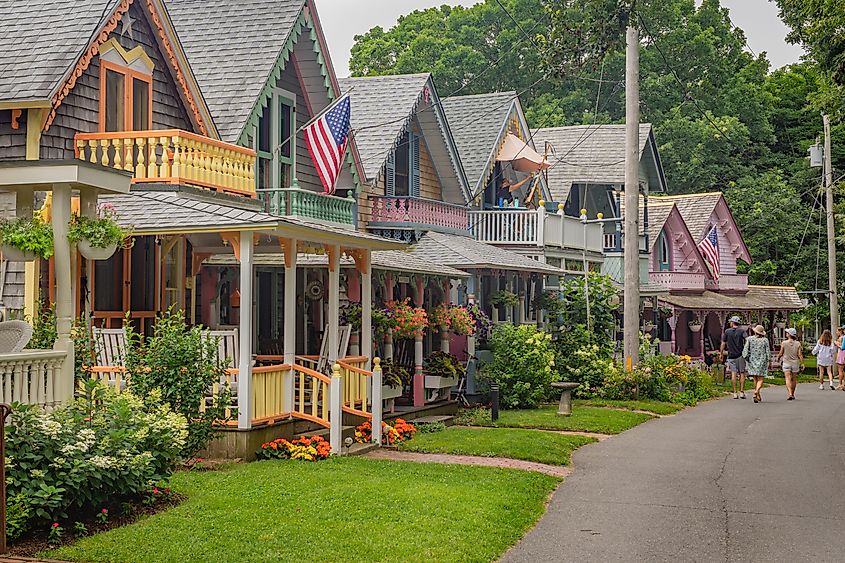
Located on the Atlantic Coast in southeastern Massachusetts, Martha’s Vineyard covers 91 square miles. Vineyard Sound separates it from Cape Cod, which lies just 4 miles to the north. While the island has over 20,000 permanent residents, this number surges in the summer, with estimates reaching between 90,000 and 200,000.
Due to its resort towns, the economy of Martha’s Vineyard depends largely on tourism and summer yachting. Its coastline features many ponds and inlets sealed by sand spits, and the highest point on the island is Peaked Hill, rising 311 feet above sea level.
Johns Island
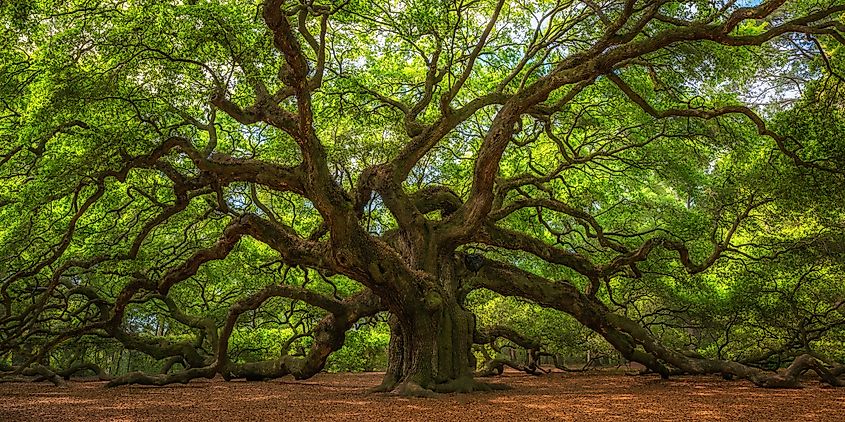
Lying along the southern coast of South Carolina, Johns Island is the tenth largest island in the contiguous US, consisting of 84 square miles. The Stono River separates it from the mainland in the northeast and the Wadmalaw River to the northwest. The island’s population is growing rapidly, having nearly doubled to around 25,000 residents over the past 10 years, largely due to its proximity to Charleston.
The geography of Johns Island is fairly flat and marshy, with many intersecting rivers. In addition to hundreds of bird species, the island is home to many alligators, bobcats, coyotes, otters, deer, and wild hogs, as well as shellfish and dolphins in the marshes and rivers. Angel Oak, a 300 to 400-year-old live Oak Tree, is a popular attraction on the island, receiving roughly 400,000 visitors annually.
The Evolving Landscapes of America's Largest Islands
While these islands share their large size, they are incredibly different in terms of populations, ecosystems, and infrastructure. Some have transformed into major population centers, while others lack even paved roads. Population trends are equally varied—some islands see significant seasonal increases due to tourism, while others, like Johns Island, have experienced rapid permanent resident growth over the past decade. Meanwhile, Marsh Island has faced substantial erosion over the past century, significantly impacting its landscape. It will be fascinating to observe how each of these islands continues to evolve in the coming decades and centuries.
Largest Islands In The Contiguous US By Land Area
| Rank | Name of Island | Area (sq mi) | Area (sq km) | Location |
|---|---|---|---|---|
| 1 | Long Island | 1,401 | 3,629 | New York |
| 2 | Padre Island | 209 | 542 | Texas |
| 3 | Isle Royale | 206 | 534 | Michigan |
| 4 | Whidbey Island | 169 | 437 | Washington |
| 5 | Drummond Island | 125 | 324 | Michigan |
| 6 | Mount Desert Island | 108 | 280 | Maine |
| 7 | Marsh Island | 100 | 259 | Louisiana |
| 8 | Santa Cruz Island | 98 | 254 | California |
| 9 | Martha's Vineyard | 91 | 236 | Massachusetts |
| 10 | Johns Island | 84 | 217 | South Carolina |
| 11 | Santa Rosa Island | 81 | 209 | California |
| 12 | Santa Catalina Island | 75 | 194 | California |
| 13 | Edisto Island | 68 | 176 | South Carolina |
| 14 | Galveston Island | 64 | 166 | Texas |
| 15 | Matagorda Island | 61 | 157 | Texas |
| 16 | Staten Island | 59 | 153 | New York |
| 17 | Orcas Island | 57 | 148 | Washington |
| 18 | Cumberland Island | 57 | 147 | Georgia |
| 19 | San Clemente Island | 57 | 147 | California |
| 20 | Hilton Head Island | 55 | 144 | South Carolina |
